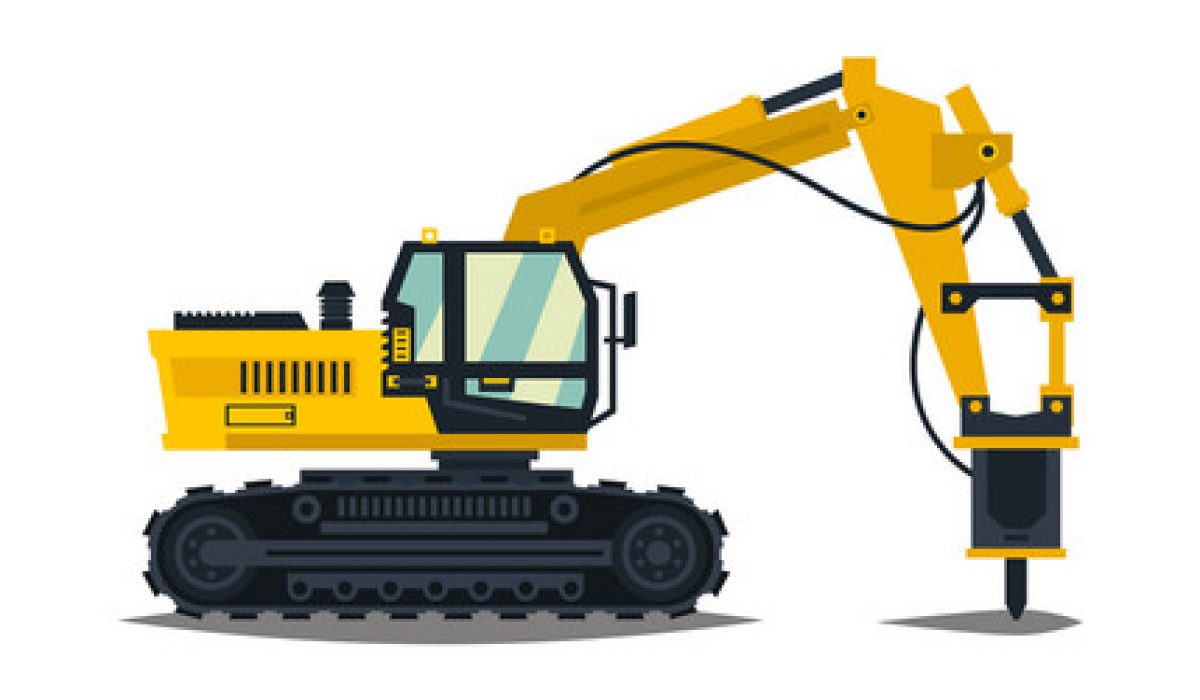A hydraulic breaker hammer is an essential tool for various heavy-duty applications, including demolition, construction, mining, and quarrying. This comprehensive guide covers all essential aspects of hydraulic breaker hammers. Discover their structure, working principles, and expert tips for purchasing, maintaining, and repairing these powerful tools. Leveraging over 20 years of industrial experience, our team provides insights to help both beginners and professionals make informed decisions and optimize their use.
What is a Hydraulic Breaker Hammer?
A hydraulic breaker hammer is a type of heavy construction machinery mounted on excavators, backhoes, skid steers, mini-excavators, and stationary plants. It disassembles concrete buildings into manageable pieces or breaks rocks into smaller sizes using hydraulic power. These versatile tools can handle a wide range of jobs, with different sizes and models to suit particular needs. A good hammer is built to last and is commonly used in applications such as demolition, construction, road building, mining, quarrying, tunneling, and landscaping.
Hydraulic Breaker Hammer Structure
To understand how a hydraulic breaker hammer works and its working principles, it’s essential to clarify its structure and major components first. A hydraulic breaker hammer consists of three main parts: the back head (nitrogen chamber), cylinder assembly, and front head.
Back Head (Nitrogen Chamber)
The back head is a chamber for storing nitrogen. When placed under high pressure, this nitrogen-filled chamber acts like a damper upon the return piston-stroke and works as an impact enhancer when the piston travels down.
Cylinder Assembly
The cylinder assembly is the core part of a hydraulic breaker hammer, consisting of a cylinder, a piston, and a control valve. The piston and valve are the only two moving parts, with the piston moving up and down to hit the tool and the valve rotating to control the oil flow’s direction. This is where the hydraulic power is generated, with the main valve controlling the oil and the hydraulic flow driving the piston movement to generate impact energy. A set of seal kits are placed inside the cylinder to prevent oil leakage.
Front Head
The front head is where the piston connects with the chisel (or working tool). The chisel is fixed with bushes and pins, which are the parts that need to be replaced most frequently. The front head touches the working surface directly, and a box-type housing can protect it from wear and lead to a longer service life.
Hydraulic Breaker Hammer Working Principle
The hydraulic breaker hammer’s working principle involves the main valve controlling the flow of oil in and out, driving the piston to move up and down and generate impact energy. This process can be broken down into four stages:
- High-pressure oil enters and fills chambers 1 and 8, acting on the piston end-face and pushing it upward.
- When the piston moves upward towards its limit, chambers 1 and 2 get connected, and oil flows from chamber 2 to 6. The control valve moves upward due to the difference in pressure.
- When the control valve reaches its upper limit, the input hole connects to the oil flow in chamber 8, which makes oil flow into chamber 4. Due to the high oil pressure in chamber 4 and nitrogen backup, the piston travels down.
- When the piston travels down and hits the chisel, chambers 3 and 2 get connected and connect to chamber 6. Because of the high oil pressure in chamber 8, the control valve travels down, and the input hole connects to chamber 7 again, starting a new circulation.
In summary, the hydraulic hammer working principle can be described as: “The relative position change of piston and valve, driven by oil flow going ‘in’ and ‘out,’ transforms hydraulic power into impact energy.”
How to Choose a Hydraulic Breaker Hammer
Selecting the right hydraulic breaker hammer is crucial for optimizing efficiency and protecting your investment. Here are six practical tips to help you choose the proper hydraulic breaker hammer:
Size
A hydraulic breaker hammer must be mounted with the right size carrier. The proper match can optimize efficiency while protecting your valuable investment in equipment. Always refer to the manufacturer’s recommendations for the appropriate carrier size range.
Application
Consider the material you will be breaking and the environment you will be working in. Different applications require different types of hydraulic breaker hammers. For example, a smaller hammer may be suitable for light-duty tasks, while a larger, more powerful hammer is necessary for heavy-duty applications like mining or quarrying.
Durability
Look for a hydraulic breaker hammer with high-quality components and a robust design. A durable hammer will provide reliable performance and a longer service life, minimizing downtime and repair costs.
Ease of Maintenance
Choose a hydraulic breaker hammer that is easy to maintain. Look for features like easy access to wear parts, simple lubrication systems, and clear maintenance instructions. Regular maintenance is essential for ensuring optimal performance and prolonging the life of your hammer.
Noise and Vibration
Consider the noise and vibration levels of the hydraulic breaker hammer, especially if you will be working in urban areas or sensitive environments. Look for hammers with advanced noise and vibration reduction technologies to minimize the impact on operators and surrounding areas.
Brand and Service
Invest in a hydraulic breaker hammer from a reputable brand with a proven track record of quality and reliability. Additionally, consider the level of service and support provided by the manufacturer or dealer, including warranty coverage, technical support, and parts availability.
Hydraulic Hammer Maintenance Guide
Regular maintenance is crucial for ensuring the optimal performance and longevity of your hydraulic breaker hammer. Here are some essential maintenance tips:
Lubrication
Proper lubrication is critical for reducing wear and tear on the hammer’s components. Follow the manufacturer’s guidelines for the type and amount of lubricant to use, and ensure that the lubrication system is functioning correctly.
Wear Parts
Regularly inspect and replace wear parts, such as the chisel, bushings, and pins, as needed. Worn or damaged parts can reduce the hammer’s efficiency and cause further damage to other components.
Nitrogen Charge
Check the nitrogen charge in the back head according to the manufacturer’s specifications. An incorrect nitrogen charge can affect the hammer’s performance and cause damage to the components.
Hoses and Connections
Inspect hydraulic hoses and connections for leaks, damage, or wear. Replace any damaged components promptly to prevent further issues and ensure the hammer’s optimal performance.
Storage
When not in use, store your hydraulic breaker hammer in a clean, dry place. Protect the hammer from the elements and ensure that it is secured to prevent accidents or damage.
For more detailed maintenance guidance, consult the manufacturer’s maintenance manual or refer to our complete PDF maintenance guide, available for download.
Frequently Asked Questions (FAQ)
How do I know if my hydraulic breaker hammer needs to be repaired?
Signs that your hydraulic breaker hammer may need repair include reduced impact energy, oil leaks, unusual noises or vibrations, and visible damage to components. If you notice any of these issues, consult a qualified technician for assistance.
Can I use any type of hydraulic oil in my breaker hammer?
No, it is essential to use the hydraulic oil that the manufacturer recommends. Using the wrong type of oil can cause damage to the hammer’s components and void the warranty.
How often should I replace the chisel on my hydraulic breaker hammer?
The frequency of chisel replacement depends on factors such as the material being broken, the hammer’s usage, and the operator’s technique. Inspect the chisel regularly for wear and damage, and replace it as needed to maintain optimal performance.
Can I use my hydraulic breaker hammer underwater?
Some hydraulic breaker hammers are designed for underwater use, while others are not. Always consult the manufacturer’s specifications and guidelines before using your hammer in underwater applications.
What should I do if my hydraulic breaker hammer is not producing enough impact energy?
Low nitrogen charge, worn or damaged components, improper hydraulic flow, and pressure are just a few of the causes of reduced impact energy. Consult the troubleshooting guide in the manufacturer’s manual or contact a qualified technician for assistance.
Conclusion
A hydraulic breaker hammer is a powerful and versatile tool that can greatly enhance productivity in various heavy-duty applications. By understanding its structure, working principles, and proper maintenance techniques, you can ensure that your hydraulic breaker hammer operates at peak performance and provides long-lasting value. When selecting a hydraulic breaker hammer, consider factors such as size, application, durability, ease of maintenance, noise and vibration levels, and brand reputation to make an informed decision that best suits your needs.
Remember to prioritize regular maintenance, including proper lubrication, wear part replacement, nitrogen charge checks, and hose and connection inspections. By following the manufacturer’s guidelines and addressing any issues promptly, you can minimize downtime, extend the life of your hammer, and maximize your return on investment.
If you encounter any problems or have questions about your hydraulic breaker hammer, consult the manufacturer’s manual, troubleshooting guide, or seek assistance from a qualified technician. With proper selection, use, and maintenance, your hydraulic breaker hammer will be a reliable and efficient tool for tackling even the most challenging jobs.
We hope that this comprehensive guide has provided you with valuable insights and information to help you make informed decisions about hydraulic breaker hammers. As industry experts with over 20 years of experience, we are committed to sharing our knowledge and helping professionals like you succeed in your projects.





